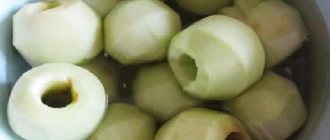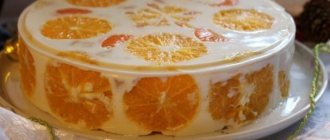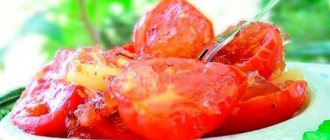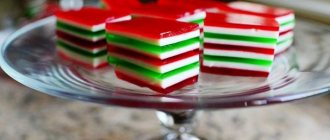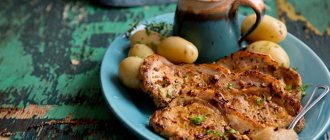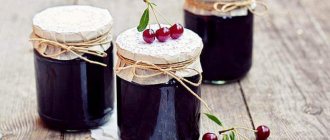Tuesday, September 18, 2021
Homemade apple jelly is a very simple but delicious dessert. It can be prepared without any problems not only in season, but at any time of the year. Today we will prepare jelly not from apple juice, but from a compote that we will cook ourselves.
To prepare this dessert, apples of absolutely any variety are suitable: sweet, sweet and sour or sour. The amount of sugar can be easily adjusted to your taste. As a flavorful addition, you can add a little mint, lemon balm, vanilla, cardamom or cinnamon to the apple compote.
Cooking step by step:
To make homemade apple jelly, we need the following ingredients: water, apples, granulated sugar and gelatin. Determine the amount of sugar according to your taste - the sweeter the apples, the less you need. I do not use instant gelatin, but one that requires pre-soaking in cold water.
Wash the apples (I have the Melba variety) and cut them into slices, cutting out the seed pods and stem. I don't remove the skin.
In this way, prepare all the apples: there are 300 grams of slices in a plate.
Pour 700 milliliters of water into a saucepan or stewpan, put the apple slices in it and put it on the fire.
Add granulated sugar (I needed 100 grams, since apples are not very sweet) and cook fruit compote.
Literally a couple of minutes after boiling so that the slices do not fall apart, and remove the pan from the stove.
Let the apple compote cool to a warm state and brew.
In the process, pour about 100 milliliters of compote into a glass or mug, let it cool and soak 20 grams of gelatin in it. Let it sit for half an hour at room temperature and swell.
The swollen gelatin needs to be dissolved. This can be done in a water bath on the stove, but it is much easier and faster to use the microwave. I dissolve the gelatin on the Defrost mode for about 10-15 seconds. Just don’t let it boil at all, otherwise the apple jelly won’t set.
Using a spoon or slotted spoon, remove apple slices from the brewed compote and pour warm (one might even say hot) gelatin into the pan. Mix everything - the jelly is almost ready, all you have to do is cool it in the refrigerator. For convenience, I pour the mixture into a jug - this will make pouring it into molds easier.
Pour the apple compote with gelatin into molds or vases - as you wish. Those slices that we caught can also be added to the jelly if desired. Place the preparations in the refrigerator for 3-4 hours so that the jelly hardens. In total, from the specified amount of ingredients used, I get 4 identical servings.
Tender, aromatic and tasty apple jelly is ready. Store it in the refrigerator and serve for dessert. Cook for your health, friends, and bon appetit!
Apple jelly prepared for the winter is a delicious dish that will come in handy for your everyday and holiday tables. Apples are a storehouse of vitamins, and even in a canned state they retain a lot of vitamins. And jelly options, supplemented with cinnamon, mint, quince, pumpkin or cranberry, will be a real find for those who would like to keep their immunity in order during the cold season.
Description
Jelly is a colorful dessert presented in the form of a colloidal food solution based on fruit and gelatin. After cooling, the mass acquires the consistency of jelly. The word came from France. In translation, “jelly” is a gel, jelly. But it is used only for sweet foods. Many people know that jelly is prepared by forming gelatin from calves' heads and legs. This product is called jellied meat or aspic.
Fresh and frozen fruits, syrups, and juices are added to dessert jellies. During cooking, gelatin is added. The latter is a product of animal origin, obtained by boiling, drying and grinding bones, tendons and other parts of the animal body. Gelatin must be used according to the recipe, otherwise adding more quantity will likely result in an unpleasant taste.
Now there are different recipes for making jelly. This can be pectin and agar-agar. These products are plant-based, making them great for jellies. They harden well even at high temperatures and do not spoil the taste of the product. Pectin should not be added in larger quantities, otherwise the dessert may become cloudy. But this will not happen with agar-agar: it is created from brown and red algae, it consists of polysaccharides, so it turns out to be a strong jelly. This product has a festively rich color and transparency, and fruit or a design on the plate should be visible through the mass.
To obtain an original taste and aroma, red wine, Madeira, sherry, lemon juice, port, and liqueur are added to desserts. The product should be served chilled, with mousses, syrups, and sweet sauces. Berries, fruit slices, slices, and whipped cream are used as decoration. For everything to work out perfectly, the bottom of the dish for pouring gelatin should be made warm, because then lumps will not appear. Aluminum containers should not be used, as the material causes the product to have an unpleasant taste and darken. There are many ways to prepare dishes, including winter jelly recipes.
General cooking principles
Apple jelly is prepared according to various recipes, but it is important to remember that the seeds and any hard parts must be removed. If they remain, the banks will certainly swell, and all the housewife’s efforts will go down the drain. With the addition of gelatin, making jelly is much faster, but still it will not be a completely natural product. But choosing a recipe without gelatin will delight you with its taste, spicy, rich aroma and unusual consistency. In any case, the applesauce is evaporated over low heat in a saucepan with thick walls and a bottom until completely thickened.
Features of preparing apricot jam with gelatin
In general, making apricot jam, rich in taste and bright in color, is not difficult. But you need to follow some rules.
Culinary experts say that the most delicious delicacy is obtained if you take 80 percent of ripe fruits, and the rest - slightly unripe. This will give a slightly sour taste.
Jam can be made without gelatin, but it will take more time. For this method, the fruits are boiled over low heat, and sugar is added during the process. Not every housewife has enough strength and patience for this procedure.
The total mass of apricots is passed through a meat grinder or a blender is used, but to get tasty pieces, some fruits are cut with a knife. The seeds must be removed, since during long-term storage hydrocyanic acid is formed in them. It should also be taken into account that:
- if you peel the apricots before cooking, the jam will be very tender;
- due to the skin, which contains pectin, preservation without gelatin is possible;
- The thickener is added a maximum of five minutes before the end of cooking, otherwise the mass will form lumps.
Selection and preparation of the main ingredient
Choosing the right apples is very important. The taste of the dish depends on them. Any variety is suitable, but the fruits must be juicy, elastic, fresh, without defects, bruises, cracks, or signs of rotting. Alas, the color of the puree will be identical in any case, so there is no point in taking bright fruits.
On average, from one kilogram of apples, if you take into account the entire process of processing and evaporation, you get up to 200 grams of jelly. Therefore, if you plan to make a kilo of jam, then you need to take 5 kilos of fresh product.
How to prepare the container?
A mandatory step is proper sterilization of the jars. You should:
- carefully inspect the containers for chips and cracks (these cannot be used);
- wash thoroughly under running cold water with detergents, you can use soda;
- rinse with boiling water and set to sterilize.
Sterilization can be carried out using various methods. If the supply of apples is large and you plan to close a lot of jars, then you can put them in the oven for 15 minutes with their necks down, and then rearrange them, preventing air from entering, on a clean cloth. If there are only a few jars, then each can be placed in the microwave or on the spout of a kettle with boiling water.
How to make apple jelly for the winter?
You can use the following recipes.
Recipe without gelatin
The recipe without using gelatin is the simplest in nature. The list of ingredients is minimal, but the taste will amaze even gourmets. The possibility of cooking without the use of gelatin is due to the fact that apples contain pectin, which itself acts as a natural thickener (therefore the skin is not removed). You will need:
- 1 kilogram of apples;
- half a liter of water;
- 400 grams of sand.
The main product is thoroughly washed, the core is removed, and cut into slices of 2-3 centimeters. Place apples in pans and add water, boil over low heat. You can’t stir, you need to wait for the juice to appear. After this, the liquid is expressed. Add sugar to the resulting broth and cook over low heat until thickened. The finished composition is laid out in jars and rolled up.
Without sterilization
To prepare thick jam you will need:
- 1 kg apples;
- 800 g sugar;
- teaspoon of citric acid.
The fruits are cut in half, the seeds are removed, and immersed in water in which citric acid is diluted. Keep for 15 minutes, after which it is prepared according to the standard recipe. Acid is a universal way to make sterilization unnecessary.
Cinnamon
For this recipe you will need:
- 2 kg apples;
- 1.5 liters of water;
- 400 grams of sugar;
- 4 sticks of natural cinnamon (do not use packaged cinnamon).
In essence, the process is identical to the standard one; cinnamon is added at the last stage (there is no need to roll with it).
With mint
The option with mint will cheer you up in cold weather. The mint must be taken fresh, only the leaves, and not all the branches at once.
For aroma, it is added to the boiling mixture; it can be left in the finished composition during rolling - it will give a greenish tint.
Jelly "Rainbow"
You will need:
- 6 bags of jelly in different colors
- gelatin 1 sachet
- 1 can of condensed milk
- water
Source: musthavemom.com
Preparation:
- It is most convenient to make this jelly in a glass baking dish or deep baking tray.
- First layer: mix one small bag of jelly of any color with hot water, as written in the instructions. Stir, cool and pour into mold. Place in the refrigerator until completely set (30-40 minutes) and make sure the baking sheet is level.
Source: musthavemom.com - Second layer: mix 4-5 tbsp. spoons of gelatin with half a glass of hot water and stir until it dissolves. Add half a can of condensed milk and another half glass of hot water. Pour this white layer over the jelly layer and refrigerate until completely set.
- Repeat layers, alternating different colors with a white layer, until you fill the entire mold.
- The white layer must be made thin, otherwise it may harden poorly and ruin the entire further process. If you see that the layer is not hardening well, add a little more gelatin to the mixture for a good result.
Source: club.chicacircle.com
Option 2. Quick apple jelly recipe
You can make a low-calorie, light jelly from apple juice. The dessert is prepared quickly and easily. Juice for jelly is either purchased or made independently from fresh fruit.
Ingredients
- 50 g granulated sugar;
- 15 g instant gelatin;
- two glasses of apple juice.
How to quickly make apple jelly
Pour gelatin into a deep bowl, pour warm apple juice, stir and leave to swell. Then place the container with the gelatin mass in a saucepan with hot water and heat it, stirring regularly, until the gelatin is completely dissolved.
Pour sugar into the remaining juice and put on fire. Cook, stirring, until the crystals dissolve. Pour in the diluted gelatin in a thin stream, stirring vigorously, cook until the first signs of boiling and remove from the stove.
Pour the warm jelly into portioned molds. Cool completely and refrigerate for three hours.
Not only gelatin can be used as a gelling agent. Pectin or agar-agar is suitable for this. They stimulate the intestines and cleanse the body of toxins.
Pasteurization and sterilization
Berry preparations are usually subjected to heat treatment.
Pasteurization
Pasteurization is a method of heat treatment of food products with the need for their disinfection and longer storage. This effect is achieved through the destruction of bacteria and microorganisms. The method was proposed by the French scientist Louis Pasteur in the mid-19th century. The method consists of one-time heating of the liquid to a temperature of 60–90 degrees. The countdown begins from the moment the set water temperature is reached. The duration of the process depends on the type of workpiece. Berry jelly is usually pasteurized for a quarter of an hour (0.5 l jars) at a temperature of 85o C.
Pasteurization is used for fruits, berries and vegetables whose cell sap is acidic.
How to pasteurize berry preparations
- Place a clean rag or wooden grate at the bottom of the bucket or pan.
- Carefully pour water into the pan. Its quantity is easy to determine - the liquid level should reach the shoulders of the jar.
- Place the jars filled with jam and cover them with lids. To prevent the lids from accidentally lifting and water from getting into the workpiece, place a weight on top. For this purpose, you can take any large flat plate.
- Turn on the heat and bring the water to the required temperature.
- We pasteurize the dessert for the period specified in the recipe.
- After heating the product, the weight is removed, and the jar, without lifting the lid, is removed from the water using special tongs and placed on a table with a soft bedding (towel or clean rag).
- The jars are hermetically sealed using a special sealing key.
Using tongs you can easily remove the jar from hot water
Sterilization
Sterilization is the basis for long and successful storage of workpieces. This process is a heat treatment of the product at a temperature of 115–120 degrees for 15–30 minutes. In addition, a popular steam sterilization method is treatment with steam under pressure for 20 minutes at a temperature of over 130 degrees.
Option 3. Apple jelly with cinnamon
Gelatin-based fruit desserts are a healthy and tasty treat. Jelly can be eaten even by those who are watching their weight. The dessert contains a minimum of calories. If you use sweet apples, you don't need to add sugar.
Ingredients
- a pinch of cinnamon and vanilla;
- half a kilogram of ripe green apples;
- 650 l of purified water;
- 15 g gelatin;
- regular sugar - three quarters.
How to cook
Wash the apples thoroughly. Cut each fruit lengthwise into four pieces. Remove the stems and core. Place the wedges in a saucepan. Dissolve sugar in water and pour liquid over apples. Place over moderate heat and cook until the fruit is soft.
Cool the boiled fruit and grind through a fine sieve. Remove the peel. Add cinnamon and vanilla to applesauce.
Pour the gelatin into a bowl, add warm water and leave to swell. Then place the container with the gelatin mixture in boiling water and keep it, stirring constantly, until it is completely dissolved. Add the gelatin mixture to the applesauce, stirring vigorously. Place in silicone molds and set in the refrigerator. Before serving, dip them in hot water for a few seconds and turn them out onto a flat plate.
Cook jelly only in enamel containers. Aluminum is absolutely not suitable for this. Upon contact with it, apples darken and lose their taste. If the fruit is sweet, you can reduce the amount of sugar.
Culinary discoveries
Making a healthy apple-based dessert at home is quick and easy.
To prepare jelly sweets based on apple juice, you will need a glass of juice, 20 grams of gelatin or another gelling mixture, lemon zest and juice, and water (100 g). Pour the gelatin with juice to swell, and at this time boil the juice of one lemon along with the zest in sweetened water. Add juice with gelatin to the water, stir constantly over low heat. As soon as the composition begins to “catch”, remove the dishes from the heat and quickly strain to remove the zest, as well as possible lumps of gelatin. Pour into a rectangular bowl with cling film on the bottom. After complete cooling and hardening, cut the apple jelly into rectangles and turn them over onto a surface sprinkled with granulated sugar.
Such sweets are much healthier than store-bought ones, and you can prepare them based on your real needs for sweets, and not on your financial capabilities.
Option 5. Apple jelly with milk and oranges
Milk-fruit jelly is a favorite treat for most children. The dessert is prepared with any fruits and berries. But apples and oranges go especially well together.
Ingredients
- 700 ml homemade milk;
- 30 g instant gelatin;
- one orange;
- 10 g vanilla sugar;
- one apple;
- 50 g sugar;
- dark chocolate - for decoration.
How to cook
Divide the milk in half. Remove the peel from the orange. Let's take it apart into pieces. We remove the film from each one. Set aside some of the pulp and squeeze out the juice from the rest. Add pulp to it.
Fill the orange mixture with milk, add half the vanilla and part of the regular sugar. Stir until the crystals dissolve. Add half the gelatin, preparing it as indicated on the package. Stir thoroughly and pour into molds, filling them halfway. We send it to freeze in the cold.
Peel the apple. Cut out the core and grind the pulp on a fine grater. Pour the applesauce with milk, add the remaining vanilla and regular sugar. Add gelatin and stir thoroughly.
Pour the milk-apple mixture over the orange mixture and refrigerate again. Sprinkle the frozen jelly with grated chocolate and serve.
To ensure that the jelly lies evenly in the mold, slightly warm the bottom before pouring the liquid into it.
Subtleties of preparing canned strawberries
Homemade berry jelly is significantly different from the transparent desserts that we treat our loved ones and ourselves from time to time. They are made from juice, milk, and sometimes pure water, simply dissolving the contents of bags of colored gelatin in it. Such delicacies can be easily cut with a knife, can be prepared without sugar - if, for example, you are on a diet - and... they cannot be stored for more than 3-4 days.
A completely different matter is homemade jelly prepared for the winter. Firstly, it doesn't have to be really dense. It is enough if the fragrant berry mass does not spread in all directions when trying to spread it on a sandwich. Secondly, during cooking you cannot do without sugar: the sweet ingredient will not only significantly improve the taste of the future delicacy, but will also increase the shelf life of your preparations, and will also promote gelling. The latter circumstance is of particular importance, since strawberries contain little natural thickener pectin (less than 0.5 g per 100 g of pulp), the lack of which is compensated by sugar.
Once you remove the lid, summer aromas will envelop you in a fragrant cloud.
The proportions of berries and sugar will vary depending on where you plan to store the summer dessert and how soon you intend to use it.
Hot-cooked jelly and packaged in jars with hermetically sealed lids will wait a year, a year and a half, or even two without any problems. Moreover, you don’t have to occupy the shelves of the refrigerator: the jars will sit comfortably in the pantry or at the back wall of the wardrobe. The main thing is to keep them away from the battery and not cause sudden temperature changes by dragging them from the room to the balcony and back. The amount of sugar needed to prepare such a delicacy is determined by each housewife independently. Classic recipes recommend a 1:1 ratio (1 kg of sugar for every kilogram of berries). But if you got a very sweet strawberry, the sweetener content can be reduced to 800–500 g, and if the berries are watery and in some places unripe, it can be increased to 1.5 kg.
Cold-prepared jelly—in other words, strawberries ground with sugar—is best kept in the refrigerator. Please note that only the densest and ripe berries of the highest grade are capable of gelling under such conditions. If the strawberries are disappointing and turn out to be watery or greenish, you won’t get the desired consistency. Which, however, will not in any way affect the taste of your homemade preparations.
It’s better not to skimp on sugar here, since the sweet ingredient will almost completely take on the role of a preservative: increase its amount to 1.5–2 kg per 1 kg of berries. And to ensure that the prepared delicacy does not ferment, additionally cover the already prepared strawberries with a layer of sugar 10–12 mm thick, creating a kind of “plug” from oxygen. Provide each jar with a tight-fitting nylon lid, and until spring you don’t have to worry about the safety of its contents.
Some housewives divide this jelly into portions and put it in the freezer.
Wild strawberries are slightly larger, denser and brighter than their strawberry sister.
Although the dessert made from garden strawberries turns out to be truly magnificent, do not miss the opportunity to prepare a jar or two of wild strawberry jelly (not to be confused with strawberries!) It has a very special taste, unique aroma and a long list of vitamins in its composition. True, some housewives believe that a delicacy made from wild berries is slightly bitter, so do not skimp on sugar - it compensates for the bitterness.
Option 6. Apple jelly with spices and lemon for the winter
You can prepare apple jelly for future use and enjoy this delicious and aromatic delicacy in winter.
Ingredients
- a pinch of saffron;
- two kg of apples;
- four cinnamon sticks;
- one and a half liters of purified water;
- 1 kg 200 g sugar;
- three lemons.
Step by step recipe
Wash the apples well, remove the core and cut into slices. Place in a saucepan.
Wash the lemons, dry and finely chop. Place in a saucepan with apples. Place cinnamon sticks here too. Fill the contents with water and bring to a boil over medium heat. Then reduce the heat and simmer, covering with a lid, until the apples are soft.
Place the apples in a sieve and leave to drain all the juice. Pour it into another bowl, add sugar, add a pinch of saffron and simmer over low heat until the liquid thickens. Remove from heat and pour into sterile dry jars. Seal tightly with lids. Turn upside down, wrap and leave until completely cool.
You can prepare jelly according to this recipe not only for the winter. It can be poured into bowls and served, after keeping it in the refrigerator until it hardens.
- Author: Maria Sukhorukikh
Rate this article:
- 5
- 4
- 3
- 2
- 1
(0 votes, average: 0 out of 5)
Share with your friends!
Nutritional and energy value:
| Ready meals | |||
| kcal 600 kcal | proteins 43.6 g | fat 0.2 g | carbohydrates 112.4 g |
| Portions | |||
| kcal 200 kcal | proteins 14.5 g | fat 0.1 g | carbohydrates 37.5 g |
| 100 g dish | |||
| kcal 57.1 kcal | proteins 4.2 g | fat 0 g | carbohydrates 10.7 g |




